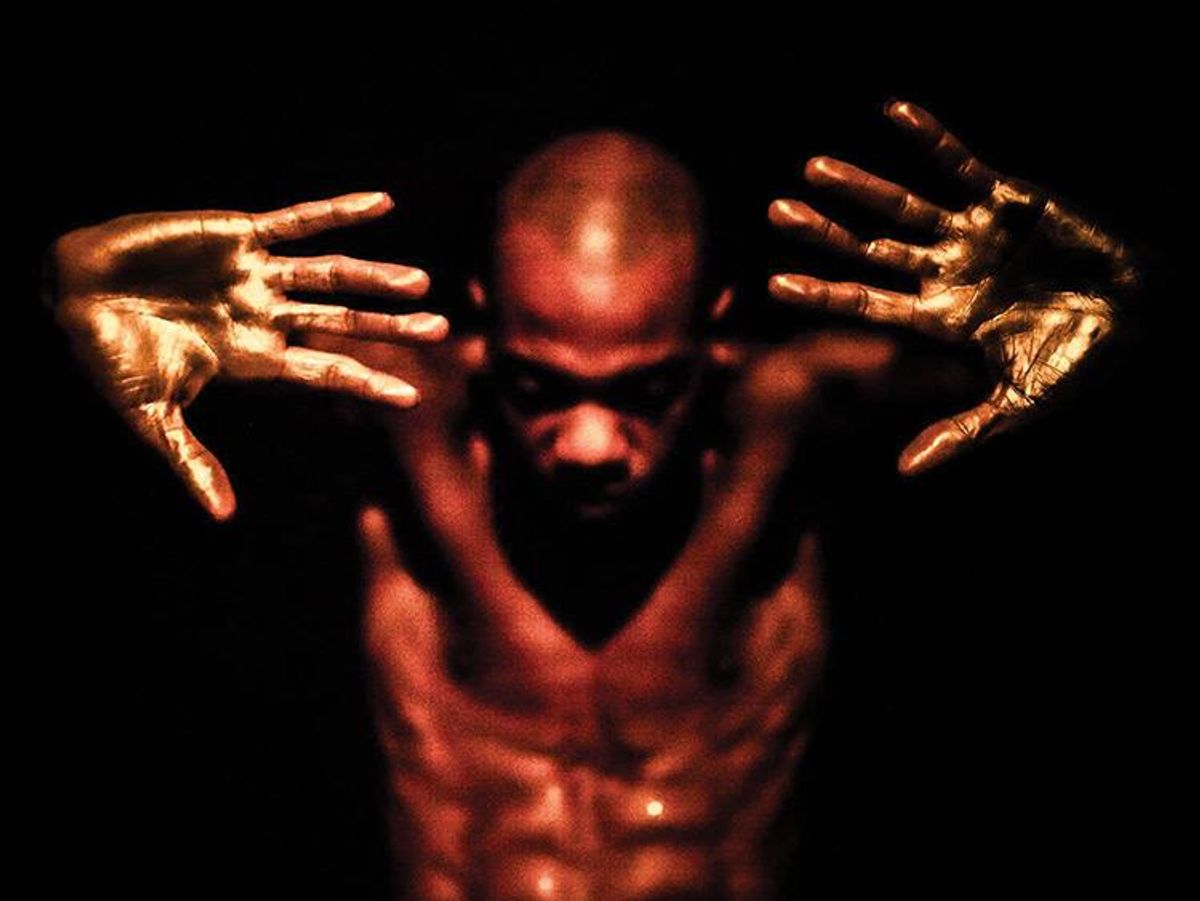Shamel Pitts has come back to America to be, in his words, part of the conversation. The performance artist and dancer, who grew up in Brooklyn, spent seven years in Israel as a company member of the country's highly regarded Batsheva Dance Company, and his return to our shores could not be more timely. In January he premiered a solo show, Black Box, in which he combines visual arts, contemporary dance, and avant-garde expressionism to interrogate his own identity.
"It is a very challenging and heated time to return to the United States with Trump as president, and with the country more divided and hurting than when I left," he says. "Yet I feel, as an artist, it is my responsibility to be here to question the heart of all these things, not just the noise and bullshit storming around them."
As most performance artists will tell you, their voice is their body. In a time of resistance and political uncertainty, particularly for people of color and the LGBTQ community, protests have resonated the loudest. But perhaps a nuanced, more delicate gesture could also move the many conversations forward, with more modulation, and less Sturm und Drang.

"I use my body to communicate something that is potentially inexplicable with words, something unseen yet felt at the core," Pitts says. "Dance can travel beyond comprehension and enter the body and mind of the viewer in a way that transcends the experience of the moment and the moments after. It lingers through us all. Dance has always been there, and it will be always."
Black Box was first staged in February 2015, on Pitts's 30th birthday, in Tel Aviv. Thirty friends were invited to watch his half-hour performance, in which he used movements and words to express his sexuality, his blackness, and what he considers his complicated place in the world. Since then, Black Box has morphed into both a short film (available online) and a solo performance.
The film is directed and produced by the Israeli director Aviv Maaravi; the live performance is set in a confined space, in nearly total darkness. The only light source is a projector that throws black light into the space, part of a collaboration with art director and lighting artist Tom Love. Layered over this is a series of recordings of Pitts's observations and ruminations, drawn from his travels with Batsheva: "Come passion and allow me to feel and decipher what is left from the distances spread inside of my chest. I look to you for strength and humanity and realness. I look towards you as a mirror that's one-sided, only showing you the multiplicity of faces that lie inside of you."

In Black Box, Pitts, clad only in a loincloth and caked in mud, moves slowly and gracefully, as if in meditation. His body seems familiar yet under-represented, the source from which the strength of his work emerges. Obliquely referencing the flight data recorder, Black Box transcends the traditional travel-journal format, becoming instead a record of a life--in a nod to Nina Simone--as a "young, gifted, and black" artist, thriving in constant motion. "There were moments of self-reflection, self-destruction, discovery, and perspective," Pitts says. "It was important to write -- to give a platform for these experiences, memories, and existential ideas." Think of it as his way of giving words the power to dance.
Pitts's project grew out of a desire to research existential questions of identity that are magnified in the world at large, a series of meditations on, in his words, "the color, the race, the orientation, the loss, the essence, the solitude, the consensus."
Black Box can be seen as a culmination of everything Pitts has worked on since his days at New York's Fiorello H. LaGuardia High School of Music & Art and Performing Arts. "The LaGuardia environment was the first--and probably most--diverse collective of humanity that I've ever experienced," he says. "I remember being so excited in a way that was unfamiliar and new, as I was learning more about myself, dance, art, other cultures, and other ways of being, among people who came from very different backgrounds."
While attending LaGuardia, Pitts was also a student at the Ailey School, founded by the great African-American dancer and choreographer Alvin Ailey, who died in 1989. It was there that Pitts was given a copy of James Baldwin's Giovanni's Room, a baptism of fire for the young dancer. "I had not heard of the book at the time, nor did I anticipate that it would have such an immense impact on my life," says Pitts. "It delves deeply and poetically into ideas of homosexuality, bisexuality, blackness, and biracial relationships. Also the turbulence of love and living abroad, so many things that I knew very little about. Yet I felt that, at my core, they were already there as a part of me."

Baldwin may have come to his aid, but Pitts was always going to dance. After honing his skills at Juilliard and dancing with Mikhail Baryshnikov's Hell's Kitchen Dance and BJM Danse Montreal, he went to Israel to dance under Ohad Naharin, artistic director of Batsheva and the man credited with creating "Gaga," a bold dance language that has come to define the form in Israel.
"Over the past seven years of living in Tel Aviv, I became a big part of the nightlife scene," Pitts says. "I realized there was space for me to bring a creative, artistic side to my presence in it." That was when he joined forces with Billy Barry, a fellow dancer from New York, to launch Fagazine, an Israel fashion blog. It took off, fueled by a series of parties he, Barry, and DJ Litty Lev held around Tel Aviv. The bashes included cellists, circus artists, twerk teams, pole dancers, hip-hop B-boys, Hula-Hoop performers, Russian avant-garde installation artists, video artists, photographers, and several professional dancers. As a symbol of opposition to conformity, they drew a line of white lipstick down their foreheads.
"More and more people wanted the white line stripe, and eventually you would see a sea of people--different shapes, sizes, and all else--with this tribal-ass white stripe on their foreheads," says Pitts. "This was very special, and an example of how diverse we can be within our tribe."
Like what you see here? Subscribe and be the first to receive the latest issue of Out. Subscribe to print here and receive a complimentary digital subscription.




























































































Cooper Koch and twin bro spark controversy with eye-popping 'White Lotus' parody